A tidal gauge at Port Vila, the capital of Vanuatu, has shown that sea levels on the island are not rising. Following the immense destruction wrought by Cyclone Pam last week, in which up to 11 people lost their lives, the country’s president sought to pin the blame on climate change and rising seas.
The category five storm hit the archipelago nation, located in the South Pacific Ocean, with winds of up to 185 miles per hour last Saturday, wiping out most of the country’s infrastructure. According to President Baldwin Lonsdale, 90 percent of the buildings have been destroyed, while the United Nations put the death toll at 11.
President Lonsdale immediately requested humanitarian assistance – and sought to blame climate change, telling press: “We see the level of sea rise… The cyclone seasons, the warm, the rain, all this is affected. This year we have more than in any year. Yes, climate change is contributing to this.”
His comments were immediately seized upon by the BBC and The Guardian, who reported the tragedy as further proof of humanity’s need to cut carbon emissions.
Even as the Islanders were wading through the rubble to begin their salvage operation, the BBC’s environment analyst Roger Harrabin was asking “Did climate change cause Vanuatu damage?” His answer: “The world authority, the Intergovernmental Panel on Climate Change,found no evidence of a link between the frequency of tropical storms and climate change.”
But Harrabin is not so easily disarmed. He insists: “There is an undisputed link between emissions and rising sea levels, which leaves poor low-lying Vanuatu increasingly vulnerable. So when a storm strikes the islands in the year that heads of governments have promised to sign an over-arching deal to protect the climate, the president’s remarks are understandable.
“He can’t be sure that the gusts of Pam were propelled by human hands. But he can be very sure that, as greenhouse gases increase, it is his people who are among the most at risk.”
The Guardian was in full agreement, breathlessly telling its readers: “Scientists say the devastation caused by Pam, the most powerful cyclone to hit the South Pacific since records began, was aggravated by climate change. However, the effect the changing climate is having on tropical storms remains largely unresolved.
“Professor Richard Betts, head of climate impacts research at the Met Office Hadley Centre, said the human contribution to sea level rise over the past 100 years was well documented and makes island nations more vulnerable to storms and particularly storm surge.
““When cyclones and other storms occur, there is already a greater risk of coastal flooding because the background sea level has risen, largely due to human-induced global warming. How much more flooding has occurred due to human action is unclear, but ongoing sea level rise can be expected to further increase this risk unless coastal protection can be improved.””
Unfortunately for the BBC, The Guardian and Professor Betts, however, sea levels in Vanuatu appear unchanged over the last decade.
Data from the tidal gauge at Port Vila, the capital of Vanuatu shows an upward trend between 1994 and 2009, but since then levels have been falling away again, returning to approximately 2004 levels last year.
Paul Homewood, writing at the Not a Lot of People Know That blog said: “It is understandable that the President of Vanuatu should want to blame Cyclone Pam on man made global warming. Depressingly, it is also no surprise that the likes of the BBC and the Guardian should repeat his claims, as if they had any scientific basis.”


COMMENTS
Please let us know if you're having issues with commenting.